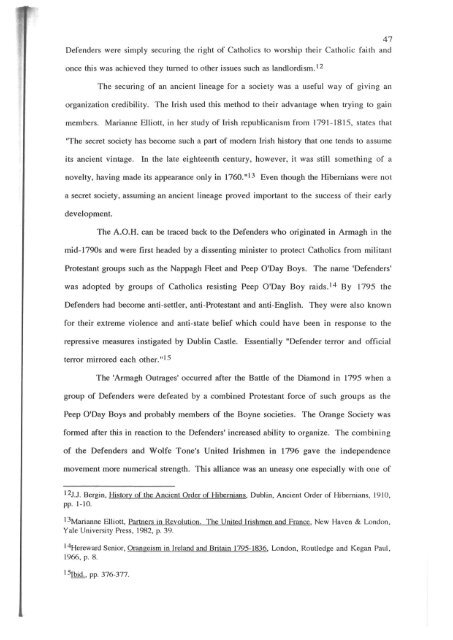TRANSPLANTED IRISH INSTITUTIONS - University of Canterbury
TRANSPLANTED IRISH INSTITUTIONS - University of Canterbury
TRANSPLANTED IRISH INSTITUTIONS - University of Canterbury
You also want an ePaper? Increase the reach of your titles
YUMPU automatically turns print PDFs into web optimized ePapers that Google loves.
47<br />
Defenders were simply securing the right <strong>of</strong> Catholics to worship their Catholic faith and<br />
once this was achieved they turned to other issues such as landlordism. 12<br />
The securing <strong>of</strong> an ancient lineage for a society was a useful way <strong>of</strong> giving an<br />
organization credibility. The Irish used this method to their advantage when trying to gain<br />
members. Marianne Elliott, in her study <strong>of</strong> Irish republicanism from 1791-1815, states that<br />
"The secret society has become such a part <strong>of</strong> modem Irish history that one tends to assume<br />
its ancient vintage. In the late eighteenth century, however, it was still something <strong>of</strong> a<br />
novelty, having made its appearance only in 1760."13 Even though the Hibernians were not<br />
a secret society, assuming an ancient lineage proved important to the success <strong>of</strong> their early<br />
development.<br />
The A.O.H. can be traced back to the Defenders who originated in Armagh in the<br />
mid-1790s and were first headed by a dissenting minister to protect Catholics from militant<br />
Protestant groups such as the Nappagh Fleet and Peep O'Day Boys. The name 'Defenders'<br />
was adopted by groups <strong>of</strong> Catholics resisting Peep O'Day Boy raids. 14 By 1795 the<br />
Defenders had become anti-settler, anti-Protestant and anti-English. They were also known<br />
for their extreme violence and anti-state belief which could have been in response to the<br />
repressive measures instigated by Dublin Castle. Essentially "Defender terror and <strong>of</strong>ficial<br />
terror mirrored each other." 15<br />
The 'Armagh Outrages' occurred after the Battle <strong>of</strong> the Diamond in 1795 when a<br />
group <strong>of</strong> Defenders were defeated by a combined Protestant force <strong>of</strong> such groups as the<br />
Peep O'Day Boys and probably members <strong>of</strong> the Boyne societies. The Orange Society was<br />
formed after this in reaction to the Defenders' increased ability to organize. The combining<br />
<strong>of</strong> the Defenders and Wolfe Tone's United Irishmen in 1796 gave the independence<br />
movement more numerical strength. This alliance was an uneasy one especially with one <strong>of</strong><br />
12J.J. Bergin, History <strong>of</strong> the Ancient Order <strong>of</strong> Hibernians, Dublin, Ancient Order <strong>of</strong> Hibernians, 1910,<br />
pp. 1-10.<br />
13Marianne Elliott, Partners in Revolution. The United Irishmen and France, New Haven & London,<br />
Yale <strong>University</strong> Press, 1982, p. 39.<br />
14Hereward Senior, Orangeism in Ireland and Britain 1795-1836, London, Routledge and Kegan Paul,<br />
1966, p. 8.<br />
ISIbid., pp. 376-377.
















